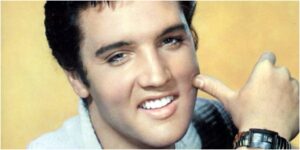The Rolling Stones had transcended music by 1974 and were much more than just a rock and roll band. Keith Richards and Mick Jagger, it is fair to say, had become idols to a generation of adolescents who saw them as the face of rebellion.
We thought here at Far Out why not cheer ourselves up by digging deep into the archives and revisit the time Richards appeared on The Old Grey Whistle to promote their new record. The highlight? Well, that would be the fact that he is totally off his face but, in classic Keith fashion, he is as endearing as ever. The wonderful Bob Harris managing to get him to open up about an array of subjects from the creative process of the band to his love of playing live and his growing friendship with Ronnie Wood.
Richards was appearing on the show to promote It’s Only Rock and Roll and this prompted Harris to quiz him about the creative decision making of the group: “Basically everybody is together to cut the tracks after that everybody sort of disappears and leaves it to Mick and I because they get confused after a while and everybody sits in the studio saying this should be louder then Mick and I just end up straddling along by ourselves,” the Stones member replied.
The conversation then took a fascinating turn to his growing friendship with Ronnie Wood and, more specifically, how his collaboration came about to appear on the former Faces man’s album who would, of course, join the Stones just a few months after this interview took place: “That came about when Mick was doing a few difficult vocals on his own for our album and I was sort of just hanging around with nothing to do particularly, one night Ronnie Wood called me up saying come down I’ve got this fantastic rhythm section,” Richards explained.
The guitarist then added, while nonchalantly smoking a cigarette in true Keith Richards style, that: “I went down there one night to see what was happening and I got roped to do a guitar overdub and after that, I lived there for a month and didn’t see daylight again. I got involved enough to write a couple of songs where Ronnie was sort of halfway through the album and I said it would be a good idea to do a couple of oldies, I like doing oldies myself and I’m a bit selfish. There’s a very nice balance of material, it turned out great and to play with that rhythm section was enough of a turn on to those gigs at Kilburn. All in all, it was very enjoyable for me.”
This chance phonecall from Ronnie Wood ended up revitalising Richards greatly. The meeting allowed him to discover another creative force that he bounced off ideas off and, importantly, would begin their working relationship together that is still going strong 46 years later.
Harris then asked him about his love of playing live and, specifically, how he was finding playing huge stadiums that had become a second home to The Stones by this time: “They get bigger and bigger every time. It’s kind of selfish if 60,000 people want to see you and you say well we want to play in a 3,000 seater hall because the other 57,000 have to lump it,” he explained. “So, I think the thing to do is do the big ballpark and the small theatre as well so 63,000 people can see you.”
It wasn’t just the amount of people in the audience that had dramatically increased, the operation of getting a Stones tour on the road by this point had also become of mammoth proportions, with Richards stating: “It’s innumerable, there’s 40 or 50 people carried about on an American tour and slightly less on a European gig. It takes a lot of time to set the tours up. I love touring, it’s the lifeblood for me. Any band that doesn’t play is only half a band as far as I’m concerned because that’s where it all comes from.”



